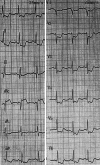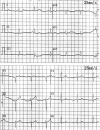Acute myocardial infarction with left main coronary artery ostial negative remodelling as the first manifestation of Takayasu arteritis: a case report
- PMID: 34809570
- PMCID: PMC8607707
- DOI: 10.1186/s12872-021-02376-w
Acute myocardial infarction with left main coronary artery ostial negative remodelling as the first manifestation of Takayasu arteritis: a case report
Abstract
Background: Takayasu arteritis is a chronic inflammatory disease involving the aorta and its major branches. Acute myocardial infarction rarely but not so much presents in patients with Takayasu arteritis, and the preferable revascularization strategy is still under debate.
Case presentation: A 22-year-old female with Takayasu arteritis presented with acute myocardial infarction. Coronary angiography and intravenous ultrasound (IVUS) showed that the right coronary artery (RCA) was occluded and that there was severe negative remodelling at the ostium of the left main coronary artery (LMCA). The patient was treated by primary percutaneous transluminal coronary angioplasty (PTCA) with a scoring balloon in the LMCA, without stent implantation. After 3 months of immunosuppressive medication, the patient received RCA revascularization by stenting. There was progressive external elastic membrane (EEM) enlargement of the LMCA ostium demonstrated by IVUS at 3 and 15 months post-initial PTCA.
Conclusion: Here, we report a case of Takayasu arteritis with involvement of the coronary artery ostium. Through PTCA and long-term immunosuppressive medication, we found that coronary negative remodelling might be reversible in patients with Takayasu arteritis.
Keywords: Case report; Coronary artery; Intravenous ultrasound; Negative remodelling; Takayasu arteritis.
© 2021. The Author(s).
Conflict of interest statement
No conflict of interest exists in this article.
Figures






Similar articles
-
Intravascular ultrasound imaging of isolated and non aorto-ostial coronary Takayasu arteritis: a case report.BMC Cardiovasc Disord. 2020 Jun 1;20(1):260. doi: 10.1186/s12872-020-01541-x. BMC Cardiovasc Disord. 2020. PMID: 32487208 Free PMC article.
-
Takayasu arteritis with coronary aneurysms causing acute myocardial infarction in a young man.Tex Heart Inst J. 2011;38(2):183-6. Tex Heart Inst J. 2011. PMID: 21494533 Free PMC article.
-
Acute non-ST segment elevation myocardial infarction as the first manifestation of Takayasu arteritis in a 16-year-old female patient: a case report and literature review.J Int Med Res. 2023 Jun;51(6):3000605231178599. doi: 10.1177/03000605231178599. J Int Med Res. 2023. PMID: 37340716 Free PMC article. Review.
-
[Successful angioplasty of the left anterior descending artery in a woman with Takayasu arteritis and associated coronary disease].Kardiol Pol. 2004 Sep;61(9):265-7; discussion 268. Kardiol Pol. 2004. PMID: 15531938 Polish.
-
Coronary artery involvements in Takayasu arteritis: systematic review of reports.Gen Thorac Cardiovasc Surg. 2020 Sep;68(9):883-904. doi: 10.1007/s11748-020-01378-3. Epub 2020 May 19. Gen Thorac Cardiovasc Surg. 2020. PMID: 32430746
Cited by
-
Effect of negative remodeling of the side branch ostium on the efficacy of a two-stent strategy for distal left main bifurcation lesions: an intravascular ultrasound study.J Geriatr Cardiol. 2024 May 28;21(5):506-522. doi: 10.26599/1671-5411.2024.05.003. J Geriatr Cardiol. 2024. PMID: 38948898 Free PMC article.
-
Refractory Takayasu's Arteritis with Severe Coronary Involvement-Case Report and Literature Review.J Clin Med. 2023 Jun 29;12(13):4394. doi: 10.3390/jcm12134394. J Clin Med. 2023. PMID: 37445428 Free PMC article. Review.
-
Coronary artery lesions in Takayasu arteritis.Reumatologia. 2023;61(6):460-472. doi: 10.5114/reum/176483. Epub 2024 Jan 18. Reumatologia. 2023. PMID: 38322104 Free PMC article. Review.
-
Clinical and vascular lesion characteristics of the patients with takayasu arteritis manifested firstly as acute myocardial infarction at onset.Heliyon. 2023 Jan 20;9(2):e13099. doi: 10.1016/j.heliyon.2023.e13099. eCollection 2023 Feb. Heliyon. 2023. PMID: 36816237 Free PMC article.
-
Clinical characteristics and risk factors of coronary artery lesions in chinese pediatric Takayasu arteritis patients: a retrospective study.Pediatr Rheumatol Online J. 2023 Apr 28;21(1):42. doi: 10.1186/s12969-023-00820-z. Pediatr Rheumatol Online J. 2023. PMID: 37118779 Free PMC article.
References
-
- Coronary artery lesions in Takayasu arteritis:Pathological considerations. Heart Vessels Suppl. 1992;7:26–31. - PubMed
-
- Amano J, Suzuki A. Coronary artery involvement in Takayasu's arteritis. Collective review and guideline for surgical treatment. J Thorac Cardiovasc Surg. 1991;102(4):554–60. - PubMed
Publication types
MeSH terms
LinkOut - more resources
Full Text Sources
Medical

